Flying to the Moon (14 page)
Read Flying to the Moon Online
Authors: Michael Collins

⦠but it sure looked strange
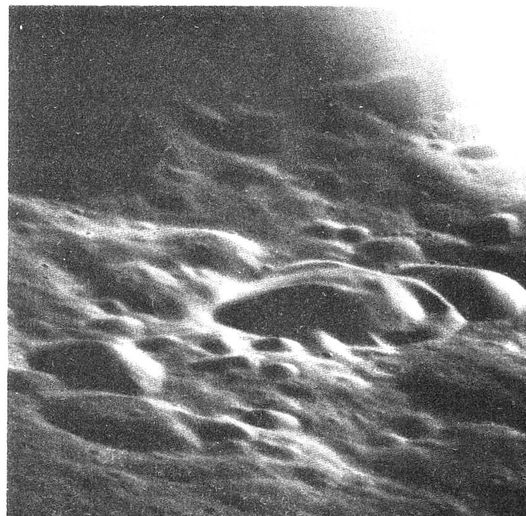
A most famous picture taken by Armstrong of Aldrin. (See Armstrong's reflection in the visor?)
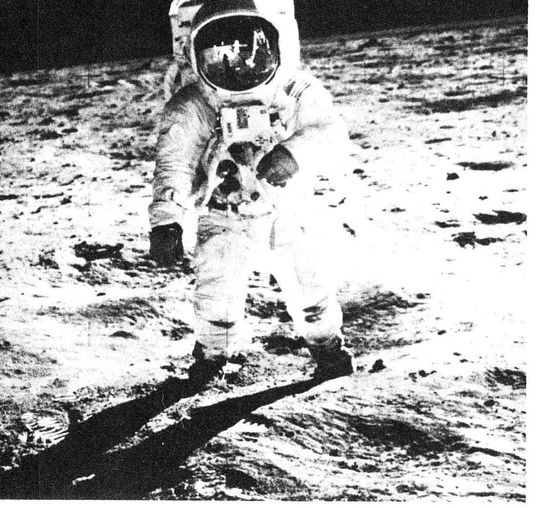
A strange but beautiful setting for the American flag
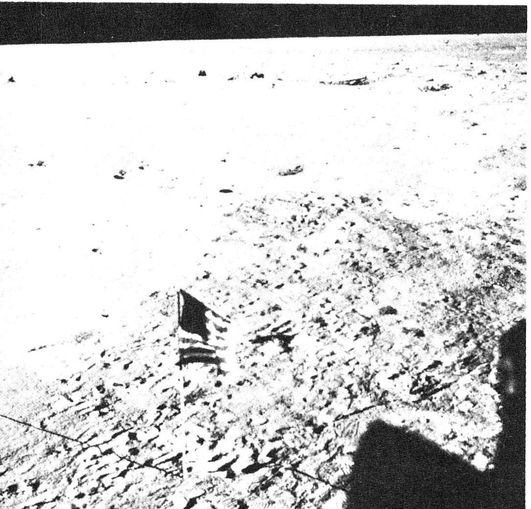
A head-on view of
Columbia,
my happy home for eight days
Columbia,
my happy home for eight days
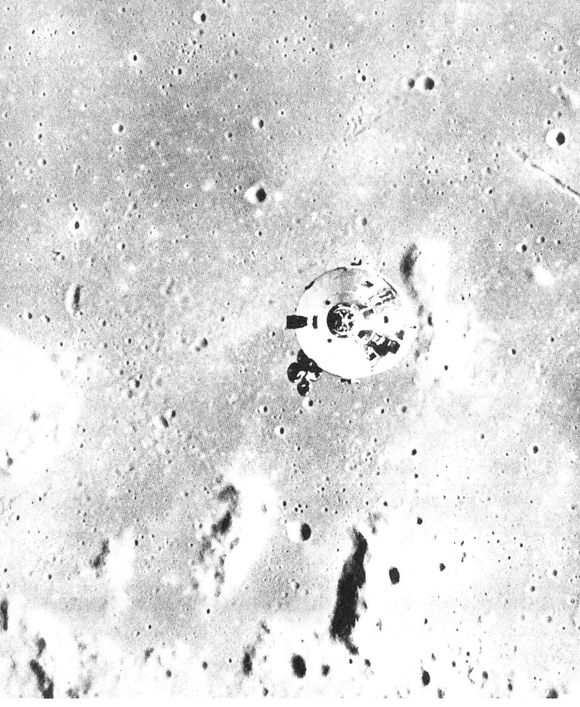
The most welcome sight of my life. Neil and Buzz returning to
Columbia
from the surface of the moon
Columbia
from the surface of the moon
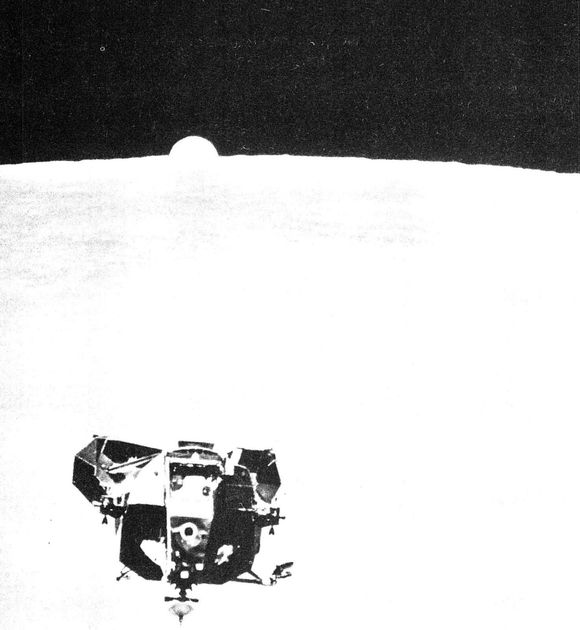
People usually guess wrong and say that this is a picture of the moon. It is really the earth but they are not accustomed to seeing the earth as a slim crescent
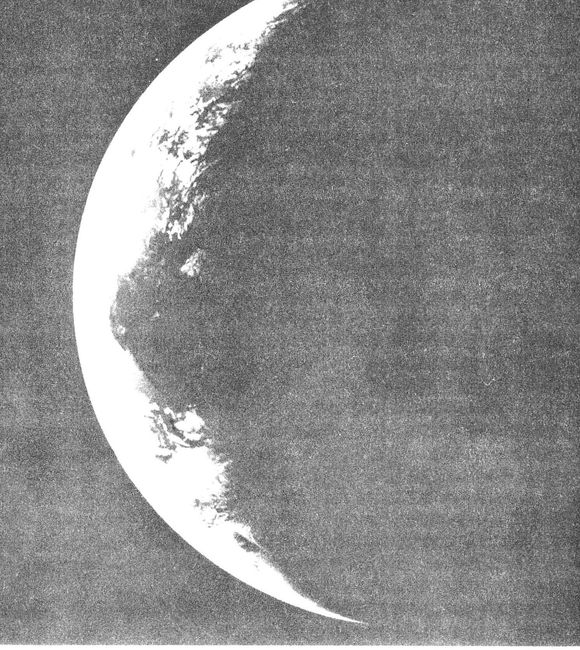
Journey's end. The three of us inside the mobile quarantine facility, listening to the President
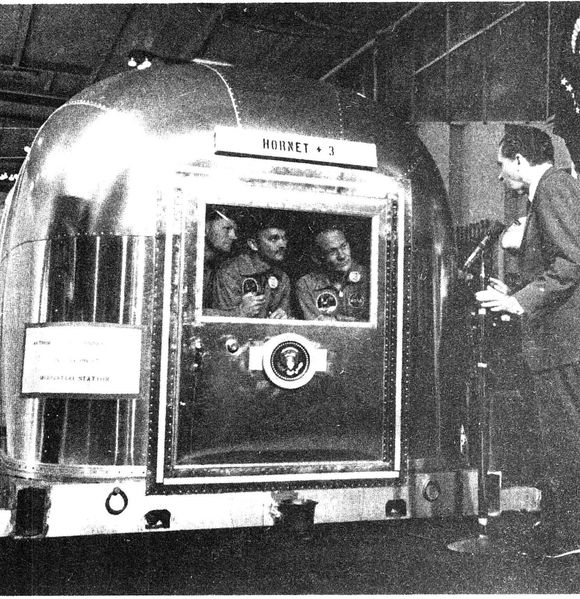
Inside
Columbia,
it was now time to switch our seats. I moved from right to left, with Neil now in the center and Buzz on the right. It was time for transposition and docking, the maneuver by which we would attach
Columbia
to
Eagle
, nose to nose. To do it, I had to fly
Columbia
away from the Saturn, and then turn around and come back and dock with
Eagle
. It was my first chance to fly
Columbia,
and it felt good. After separating and turning around, I approached
Eagle
, which looked like a mechanical spider crouched in its hole atop the Saturn. I brought the two vehicles together gently, with a slight bump as
Columbia'
s docking probe mated with
Eagle'
s drogue. Then I slipped down out of the couch and into
Columbia'
s tunnel, removing
the docking probe as I went. I connected a couple of wires, and now
Eagle
was receiving electricity from
Columbia.
The next step was to throw a switch which separated
Eagle
from the Saturn and allowed
Eagle
and
Columbia
to float free. The poor old Saturn was finished now; it was an empty carcass destined to orbit the sun.
Columbia,
it was now time to switch our seats. I moved from right to left, with Neil now in the center and Buzz on the right. It was time for transposition and docking, the maneuver by which we would attach
Columbia
to
Eagle
, nose to nose. To do it, I had to fly
Columbia
away from the Saturn, and then turn around and come back and dock with
Eagle
. It was my first chance to fly
Columbia,
and it felt good. After separating and turning around, I approached
Eagle
, which looked like a mechanical spider crouched in its hole atop the Saturn. I brought the two vehicles together gently, with a slight bump as
Columbia'
s docking probe mated with
Eagle'
s drogue. Then I slipped down out of the couch and into
Columbia'
s tunnel, removing
the docking probe as I went. I connected a couple of wires, and now
Eagle
was receiving electricity from
Columbia.
The next step was to throw a switch which separated
Eagle
from the Saturn and allowed
Eagle
and
Columbia
to float free. The poor old Saturn was finished now; it was an empty carcass destined to orbit the sun.
With the third hurdle behind us, we still had a couple of more tasks to perform before our day was over. One was very pleasant: crawling out of our pressure suits and stowing them away in bags. It made the inside of
Columbia
seem much larger. We felt safe enough in
Columbia
as long as we weren't going to pop loose from
Eagle
(which would have let all our air out), and I had checked the tunnel connections to
Eagle
several times. Once out of my suit, I did some practice navigating, finding several stars and measuring the angle between them and the earth's horizon. Then it was time to start worrying about temperatures inside
Columbia
and
Eagle.
We were between the earth and the moon, in constant sunlight. If we held the spacecraft in any one position, the side facing the sun would become too hot and the side in the shadows would become too cold. Too hot meant propellant-tank pressures rising dangerously high; too cold meant radiators freezing. To prevent either, we had to position the spacecraft broadside to the sun, and then begin to turn slowly, like a chicken on a barbecue spit.
Columbia
seem much larger. We felt safe enough in
Columbia
as long as we weren't going to pop loose from
Eagle
(which would have let all our air out), and I had checked the tunnel connections to
Eagle
several times. Once out of my suit, I did some practice navigating, finding several stars and measuring the angle between them and the earth's horizon. Then it was time to start worrying about temperatures inside
Columbia
and
Eagle.
We were between the earth and the moon, in constant sunlight. If we held the spacecraft in any one position, the side facing the sun would become too hot and the side in the shadows would become too cold. Too hot meant propellant-tank pressures rising dangerously high; too cold meant radiators freezing. To prevent either, we had to position the spacecraft broadside to the sun, and then begin to turn slowly, like a chicken on a barbecue spit.
Once we had this motion established, we could relax and watch the earth and the moon slowly parade past our windows. The moon didn't seem to be getting much bigger, but the earth was definitely shrinking. By the end of our first day in space, the earth barely filled one small window.
It was really bright, with the blue of the ocean and the white of the clouds being what you noticed most. The green of the jungle areas was not distinct at all, and though the rust-colored sandy deserts were quite visible, the main impression was one of clouds and sea. We usually think of the moon as being quite bright, especially when it is full, but the moon is a dullard compared to the earth. In technical terms, the albedo of the moon is .07, which means that it bounces back only 7 percent of the light striking it, absorbing the other 93 percent. The earth's albedo is four times that of the moon, which means it shines four times as brightly. The sunshine really bounces off it, especially off the surface of the ocean, and if your eyes and the sun are in just the right position, the ocean will sparkle and flash like a fine diamond held up to a bright light. As I got ready for bed, I tried to decide what you called where we were. It is usually described as “cislunar space,” but that really wasn't a good name for this strange region. We were in constant sunlight, which meant it was “daytime,” but if you looked away from the sun, the sky was black as pitch. No stars were visible, even though they were there, just as they always had been. The reason they could not be seen was that sunlight was flooding the inside of
Columbia,
which meant that the pupils of our eyes automatically narrowed until only very bright objects could be seen. The only way to see the stars was to block out the sunshine and allow the pupils to expand for several minutes. Then the stars would gradually reappear, but were gone in a flash if the eye was exposed to sunshine, either directly or bouncing off some part of the spacecraft.
It was really bright, with the blue of the ocean and the white of the clouds being what you noticed most. The green of the jungle areas was not distinct at all, and though the rust-colored sandy deserts were quite visible, the main impression was one of clouds and sea. We usually think of the moon as being quite bright, especially when it is full, but the moon is a dullard compared to the earth. In technical terms, the albedo of the moon is .07, which means that it bounces back only 7 percent of the light striking it, absorbing the other 93 percent. The earth's albedo is four times that of the moon, which means it shines four times as brightly. The sunshine really bounces off it, especially off the surface of the ocean, and if your eyes and the sun are in just the right position, the ocean will sparkle and flash like a fine diamond held up to a bright light. As I got ready for bed, I tried to decide what you called where we were. It is usually described as “cislunar space,” but that really wasn't a good name for this strange region. We were in constant sunlight, which meant it was “daytime,” but if you looked away from the sun, the sky was black as pitch. No stars were visible, even though they were there, just as they always had been. The reason they could not be seen was that sunlight was flooding the inside of
Columbia,
which meant that the pupils of our eyes automatically narrowed until only very bright objects could be seen. The only way to see the stars was to block out the sunshine and allow the pupils to expand for several minutes. Then the stars would gradually reappear, but were gone in a flash if the eye was exposed to sunshine, either directly or bouncing off some part of the spacecraft.
Our second day in space was a very quiet oneâthe first
such day I had ever known. It was pleasant to see the earth getting smaller and smaller in our windows. There was absolutely no sensation of speed. We seemed to be just hanging there, as we went about our chores. Neil and Buzz spent most of their time studying
Eagle
checklists and procedures, while I attended to all the machinery inside
Columbia.
We ignited
Columbia'
s rocket engine once, for just three seconds, to adjust our course slightly. The moon was pulling us, the earth was pulling us, and the sun was pulling us. The result of this tug of war was a curved path through the skies, and a constantly changing speed. We had been slowing down ever since we left the earth and would continue to do so until we got much closer to the moon, at which time its gravitational field would take over and we would start speeding up again. The three-second correction put us back on the center line of our imaginary highway.
such day I had ever known. It was pleasant to see the earth getting smaller and smaller in our windows. There was absolutely no sensation of speed. We seemed to be just hanging there, as we went about our chores. Neil and Buzz spent most of their time studying
Eagle
checklists and procedures, while I attended to all the machinery inside
Columbia.
We ignited
Columbia'
s rocket engine once, for just three seconds, to adjust our course slightly. The moon was pulling us, the earth was pulling us, and the sun was pulling us. The result of this tug of war was a curved path through the skies, and a constantly changing speed. We had been slowing down ever since we left the earth and would continue to do so until we got much closer to the moon, at which time its gravitational field would take over and we would start speeding up again. The three-second correction put us back on the center line of our imaginary highway.
With plenty of time to prowl around inside
Columbia,
I found that weightlessness made it seem like a completely different place than it had been on the ground. On earth the tunnel, for example, was simply waste space overhead, but here it turned into a pleasant little nook where you could sit, or crouch, or whatever you wanted to call just being there, out of everyone else's way. I found that corners and tunnels were good places; you could wedge yourself in and did not need a lap belt or anything to hold you in place. In weightlessness, you have to be wedged in, or tied down, or your body will float aimlessly, banging into other people or equipment as it goes. At first, just floating around is great fun, but then after a while it becomes annoying, and you want to stay in one place. Day
number 2 was so quiet I even had time to do some exercise. I found a spot near the navigator's panel that was just wide enough to allow my body to stretch out, with my arms over my head touching one wall and my feet another. In this position, I could “run” in place. With my medical sensors still attached to my chest, I could find out from the people in Houston what my heart rate was. I exercised until it doubled, from fifty to one hundred beats per minute, and then I stopped, because I didn't want to get too hot or sweaty, with no bath or shower on board. We also had a TV show on day number 2, using our TV camera to show the people back home what their puny little planet looked like from 130,000 miles away. By pointing the camera out the window at the earth, and then turning it over in my hands, I could make the earth appear to tumble, not something you get to do every day. I told Houston: “O.K., world, hang on to your hat. I'm going to turn you upside down.”
Columbia,
I found that weightlessness made it seem like a completely different place than it had been on the ground. On earth the tunnel, for example, was simply waste space overhead, but here it turned into a pleasant little nook where you could sit, or crouch, or whatever you wanted to call just being there, out of everyone else's way. I found that corners and tunnels were good places; you could wedge yourself in and did not need a lap belt or anything to hold you in place. In weightlessness, you have to be wedged in, or tied down, or your body will float aimlessly, banging into other people or equipment as it goes. At first, just floating around is great fun, but then after a while it becomes annoying, and you want to stay in one place. Day
number 2 was so quiet I even had time to do some exercise. I found a spot near the navigator's panel that was just wide enough to allow my body to stretch out, with my arms over my head touching one wall and my feet another. In this position, I could “run” in place. With my medical sensors still attached to my chest, I could find out from the people in Houston what my heart rate was. I exercised until it doubled, from fifty to one hundred beats per minute, and then I stopped, because I didn't want to get too hot or sweaty, with no bath or shower on board. We also had a TV show on day number 2, using our TV camera to show the people back home what their puny little planet looked like from 130,000 miles away. By pointing the camera out the window at the earth, and then turning it over in my hands, I could make the earth appear to tumble, not something you get to do every day. I told Houston: “O.K., world, hang on to your hat. I'm going to turn you upside down.”
Other books
Firewall by DiAnn Mills
The Sweetest Dare by Leigh Ellwood
Bones and Bagger (Waldlust Series Book 1) by Ted Minkinow
Edge of Dark by Brenda Cooper
Gina Cresse - Devonie Lace 04 - A Deadly Change of Power by Gina Cresse
Don't Forget Me! by R.L. Stine
Las pinturas desaparecidas by Andriesse Gauke
A Death In Beverly Hills by David Grace
Rhapsody (The Bellator Saga Book 5) by Cecilia London
The Elephant Mountains by Scott Ely
